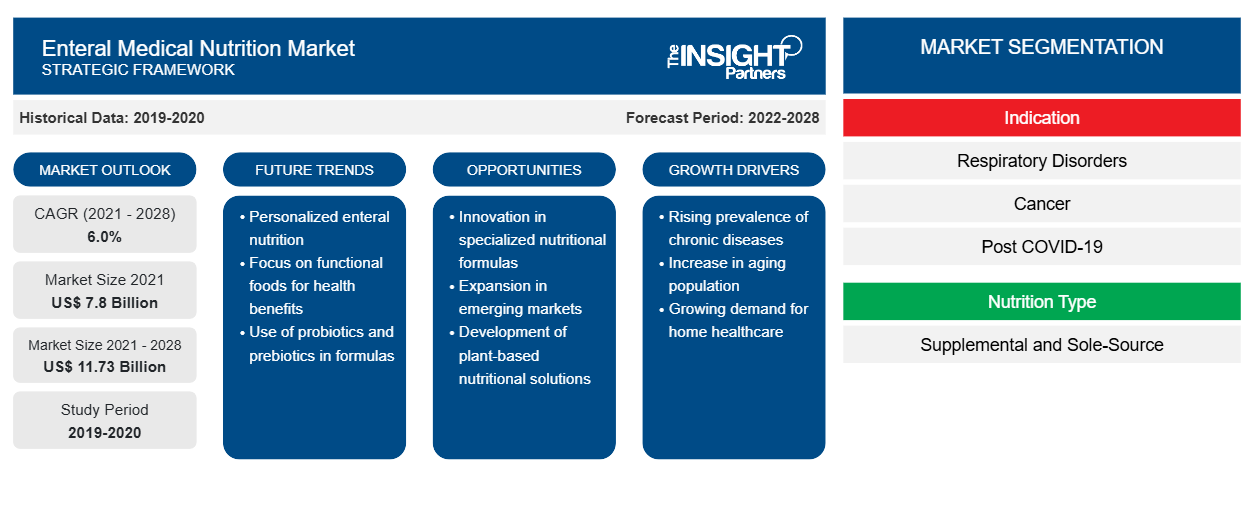肠内医学营养市场规模预计将从 2021 年的 78.0345 亿美元增至 2028 年的 117.2637 亿美元;预计 2022 年至 2028 年的复合年增长率为 6.0%。
肠内营养 (EN) 适用于无法通过常规食物摄入满足能量和营养需求的患者。肠内摄入相较于肠外营养的优势已得到广泛认可。对于大多数依赖肠内营养的儿科患者来说,适合年龄的富含纤维的标准聚合物配方是合适的选择。
肠内营养市场根据适应症、营养类型、形式、产品、分销渠道、年龄组和地域进行细分。按地域划分,市场大致分为北美、欧洲、亚太地区、中东和非洲以及南美和中美洲。该报告提供了对市场的见解和深入分析,强调了市场趋势和市场动态等参数,以及全球领先市场参与者的竞争分析。
定制此报告以满足您的需求
您可以免费定制任何报告,包括本报告的部分内容、国家级分析、Excel 数据包,以及为初创企业和大学提供优惠和折扣
- 获取此报告的关键市场趋势。这个免费样品将包括数据分析,从市场趋势到估计和预测。
市场洞察
恶病质患病率增加
恶病质是一种多功能性疾病,可导致体重极度下降、骨骼肌和脂肪组织丢失、代谢调节失衡以及食物摄入减少,是几乎所有慢性疾病进展到晚期时的严重临床后果。据美国国家生物技术信息中心(NCBI)统计,2016年终末期慢性心力衰竭患者恶病质的患病率为5%~15%,常见于慢性肾脏病、慢性阻塞性肺病(COPD)、神经系统疾病、类风湿性关节炎等患者。重度COPD患者恶病质的年死亡率为15%~25%,慢性心力衰竭或慢性肾脏病患者恶病质的年死亡率为20%~40%。
癌症恶病质会影响癌症患者的生活质量,降低抗癌化疗的疗效,增加化疗的毒性,导致癌症相关死亡率和医疗资源支出的增长。据Globocan报道,世界卫生组织报告,2018年有960万人死亡,1810万新发癌症病例。此外,癌症恶病质是一种消耗综合征,发生在高达80%的癌症患者中。根据北京呼吸与危重病医学科发表的文章,胰腺癌和胃癌患者恶病质的患病率为87%;结肠癌、肺癌和前列腺癌患者恶病质的患病率为61%;乳腺癌、肉瘤、白血病和霍奇金淋巴瘤患者恶病质的患病率为~40%。此外,20%的癌症相关死亡是由于恶病质造成的。在恶病质中,体内的营养物质减少。因此,需要提供外部营养物质来继续治疗癌症和COPD。医生更倾向于通过肠内途径为患者提供这些所需的营养物质。因此,由于各种慢性疾病发病率上升而导致的恶病质患病率不断上升,推动了肠内医疗营养市场的增长。
指示见解
根据适应症,肠内医学营养市场细分为呼吸系统疾病、癌症、新冠后、胃肠道疾病、肝功能衰竭等。呼吸系统疾病细分市场进一步细分为慢性阻塞性肺病 (COPD)、呼吸衰竭、囊性纤维化等。癌症细分市场细分为癌症恶病质、伴有 COPD 的恶病质等。胃肠道疾病细分市场进一步细分为肠梗阻、短肠梗阻、克罗恩病等。呼吸系统疾病细分市场在 2021 年占据最大市场份额。然而,预计在预测期内,癌症细分市场将录得 7.6% 的最高复合年增长率。雅培生产的 Pulmocare 专为患有 COPD、囊性纤维化或呼吸衰竭的人设计。高热量、改良的碳水化合物和脂肪 肠内配方可以帮助这些患者减少饮食引起的二氧化碳产生。
营养类型洞察
根据营养类型,全球肠内医学营养市场分为补充营养和单一来源营养。补充营养部分在 2021 年占据了更大的市场份额。然而,单一来源营养部分预计在预测期内将实现更高的复合年增长率。接受补充营养来源的患者必须在医院住院一段时间。为患者提供富含 omega-3 脂肪酸、核糖核酸和谷氨酰胺或精氨酸的肠内配方。例如,Jevity 是一种营养配方,旨在为接受短期或长期管饲方案的成年人提供补充或单一来源营养。同样的配方的热量密度为每毫升 1.0、1.2 和 1.5 卡路里。Jevity 配方还可以帮助满足患者的日常蛋白质和纤维需求。
表单洞察
根据形式,全球肠内医学营养市场分为粉末、液体和半固体。半固体部分在 2021 年占据了最大的市场份额,预计在预测期内将实现最高的复合年增长率。
产品洞察
根据产品,全球肠内营养市场细分为标准蛋白质饮食、高蛋白质饮食、果汁类口服营养品等。2021 年,标准蛋白质饮食部分占据了最大的市场份额。然而,果汁类口服营养品部分预计在预测期内将实现最高的复合年增长率。
分销渠道洞察
根据分销渠道,肠内营养市场分为医院药房、零售店和其他药房。医院药房部分在 2021 年占据了最大的市场份额。然而,预计零售店部分在预测期内的复合年增长率最高。
年龄组洞察
根据年龄,肠内营养市场分为儿童(18 岁以下)和成人(18 岁以上)。2021 年成人(18 岁以上)占据了更大的市场份额。然而,儿童(18 岁以下)细分市场预计在预测期内将录得更高的复合年增长率。
肠内医疗营养市场区域洞察
Insight Partners 的分析师已详细解释了预测期内影响肠内医疗营养市场的区域趋势和因素。本节还讨论了北美、欧洲、亚太地区、中东和非洲以及南美和中美洲的肠内医疗营养市场细分和地理位置。

- 获取肠内医学营养市场的区域特定数据
肠内医学营养市场报告范围
| 报告属性 | 细节 |
|---|---|
| 2021 年市场规模 | 78亿美元 |
| 2028 年市场规模 | 117.3亿美元 |
| 全球复合年增长率(2021 - 2028) | 6.0% |
| 史料 | 2019-2020 |
| 预测期 | 2022-2028 |
| 涵盖的领域 | 按适应症
|
| 覆盖地区和国家 | 北美
|
| 市场领导者和主要公司简介 |
|
肠内医学营养市场参与者密度:了解其对业务动态的影响
肠内医疗营养市场正在快速增长,这得益于终端用户需求的不断增长,而这些需求又源于消费者偏好的不断变化、技术进步以及对产品优势的认识不断提高等因素。随着需求的增加,企业正在扩大其产品范围,进行创新以满足消费者的需求,并利用新兴趋势,从而进一步推动市场增长。
市场参与者密度是指在特定市场或行业内运营的企业或公司的分布情况。它表明在给定市场空间中,相对于其规模或总市场价值,有多少竞争对手(市场参与者)存在。
在肠内医学营养市场运营的主要公司有:
- 雅培实验室
- 纽迪西亚
- 费森尤斯卡比公司
- B. Braun Melsungen AG
- 雀巢公司
免责声明:上面列出的公司没有按照任何特定顺序排列。

- 了解肠内医疗营养市场顶级关键参与者概况
肠内医学营养市场 – 按地区
按地域划分,全球市场分为北美洲(美国、加拿大和墨西哥)、欧洲(英国、德国、法国、意大利、西班牙和欧洲其他地区)、亚太地区(中国、日本、印度、澳大利亚、韩国和亚太地区其他地区)、中东和非洲(阿联酋、沙特阿拉伯、南非和中东和非洲其他地区)以及南美洲和中美洲(巴西、阿根廷和南美洲和中美洲其他地区)。
公司简介
- 历史分析(2 年)、基准年、预测(7 年)及复合年增长率
- PEST和SWOT分析
- 市场规模、价值/数量 - 全球、区域、国家
- 行业和竞争格局
- Excel 数据集
近期报告
相关报告
客户评价
购买理由
- 明智的决策
- 了解市场动态
- 竞争分析
- 客户洞察
- 市场预测
- 风险规避
- 战略规划
- 投资论证
- 识别新兴市场
- 优化营销策略
- 提升运营效率
- 顺应监管趋势





















 获取免费样品 - 肠内医学营养市场
获取免费样品 - 肠内医学营养市场